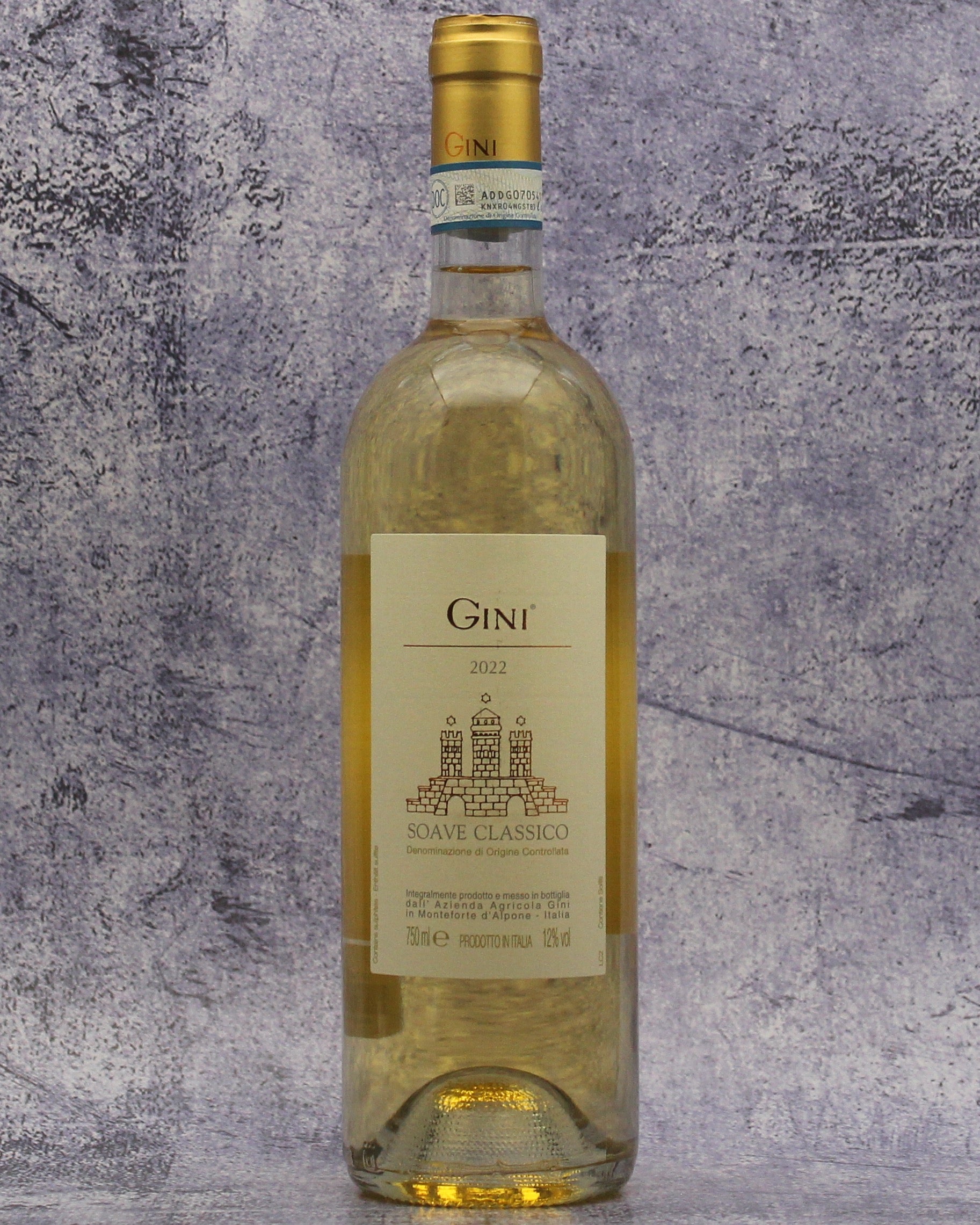Description
From: Soave, Italy
Varietal: Garganega
Taste & Critical Acclaim: The 2022 Gini Soave Classico is elegant, showcasing hints of yellow flowers, wet stone, and fresh pear slices. Its entrance is mineral-driven and impressive, with aromatic orchard fruits blossoming into a tension-filled stone-fruit core and a saline touch reappearing near the finish. Notes of pear and peach skins linger, concluding with a subtle herbal tea nuance. This Classico blends grapes from some of the region's premier vineyards, boasting an impressive average vine age of 90 years.
92 James Suckling
The custodian of the oldest vines in Soave, a great many pre-phylloxera centurions, while the majority are circa 70-years-old. All tank fermented. Exemplary Soave classico, with white pepper, jasmine, glazed quince and peach pith, steely and dry, careening along a rail of saline mineral perk. Breadth, freshness, vinosity and phenolics, serving as a sheath of compression to the sheer intensity of the house style.
Pairing: The refreshing and versatile nature of the 2022 Gini Soave Classico makes it an ideal companion for a wide array of dishes. Its crisp acidity and harmonious flavors work well with pasta dishes, fish, and white meat (poultry). The wine's lively floral and fresh herbal notes complement lighter fare, such as salads, vegetable dishes, and seafood.
For a regional Italian pairing, consider serving the Soave Classico alongside a classic Venetian dish, such as risotto with peas and pancetta or bigoli pasta with a creamy white wine sauce and fresh herbs. Alternatively, pair it with a seafood risotto, a simple grilled branzino, or polenta with shrimp and asparagus, or that same polenta base with a mushroom ragù. The wine's crisp acidity and complex flavors will enhance the risotto's creaminess and complement the mushrooms' earthiness.
Vegetarians can delight in the wine's versatility as well. Pair the 2022 Gini Soave Classico with a delicate goat cheese, spinach tart, savory mushroom & leek risotto, or a grilled vegetable and halloumi skewer. For a lighter option, consider a fresh Caprese salad, an arugula and pear salad with a lemon vinaigrette, or a Mediterranean-inspired couscous with roasted vegetables and feta cheese (recipe below).
Pearl Couscous With Creamy Feta and Chickpeas
By Melissa Clark
About. The Gini family has roots in the Soave Classico region dating from the eighteenth century and owns 25 hectares of vineyards on the very best hillside position of the appellation. Extremely low yields, low-interference viticulture, and devoted attention to the expression of the particular crus results in wines that are not only among the greatest Soaves but also among the great white wines of all Italy.
Olinto Gini and sons Sandro and Claudio have finally completed their beautiful new cellar, which extends deep into the rocky and tufaceous hillside of Monteforte d'Alpone, thus providing optimal natural temperature and humidity control.
Both tradition and the modern are reflected at Gini. The hand-harvested Soave Classicos are 100% Garganega, though many in the zone blend in other varietals to compensate for the shortcomings of less-than-perfect grapes. The Soave Classico and the single-vineyard “La Frosca” (which received 90 pts from Tanzer for the 2006 vintage and three glasses in the 2008 Gambero Rosso guide) are vinified in stainless steel. The rich, concentrated “Salvarenza”, from a tiny plot of 80-year-old vines within the La Frosca vineyard, is matured in barriques (92 pts Tanzer for the 2005 vintage.) The Re Nobilis is a rare representative of a botrytized style Recioto, northern Italy’s version of a German TBA. At the same time, the Recioto Col Foscarin is a delightful dessert wine with cheese.
At the estate, “natural agriculture” is carried out - Gini is practicing organic. The vines maintain a low production and adhere to biodynamic standards (pruning occurs per the moon's phases). Integrated insect and disease control is followed. Insecticides are not used. Copper and sulfur-based products control fungus, and manure fertilizes the soil. Spontaneous cover crops (grass cover) are left between the rows of vines, the grass cover is mowed, and the turf is left in place (the soil is not tilled). Very low doses of SO2 are added to the wine only after fermentation and before bottling to preserve the product.
About the region. Among Italy’s classic whites capable of great potential, Soave is named after the medieval village and surrounding hillsides from whence it comes. The original, historical Soave zone, delimited back in 1927, covers the eastern volcanic hillsides of today's general Soave zone and is called Soave Classico.
Garganega, the indigenous grape responsible for great Soave, produces medium-bodied white wines with fine acidity. Typical in the best Soaves are lively, flowery, and fresh herbal aromas and flavors such as orange zest, peach, melon, and marjoram. The best can take some age and, in so doing, develop notes of chamomile, marmalade, and honey.
By the 1960s and 70s, Soave was enjoying such a glorious global reputation that its demand forced growers to push beyond the zone's original borders. Expansion led west out of the hills and onto the alluvial plain of the Adige River. This, coupled with increased yields and allowance of additional varieties such as Trebbiano, Chardonnay, and Pinot blanc, met demand but created a softer, fruit-forward, everyday Soave.
Today, the broader region can source charming and value-driven whites. But those labeled as Soave Classico or, in rare cases, Soave Colli Scaligeri (nearby hillside vineyards abutting the Classico zone) will be the best quality and age-worthy Soaves. These are often 100% Garganega.

